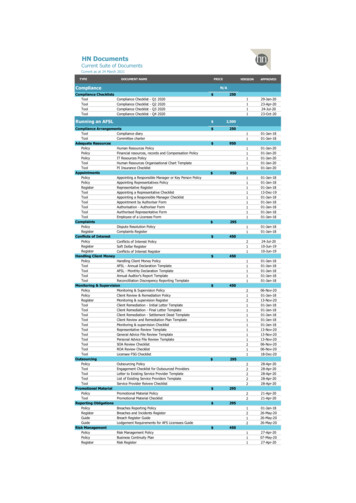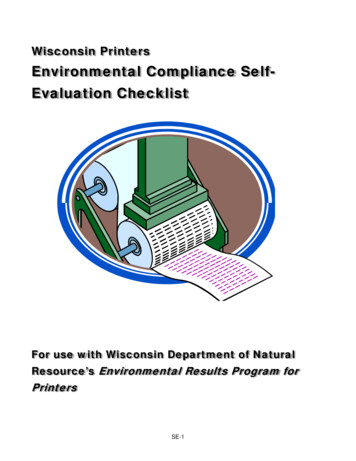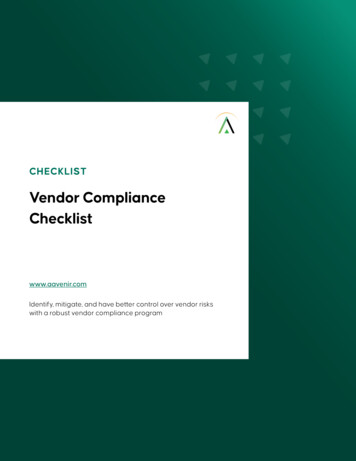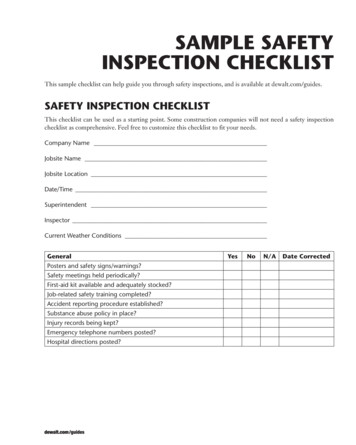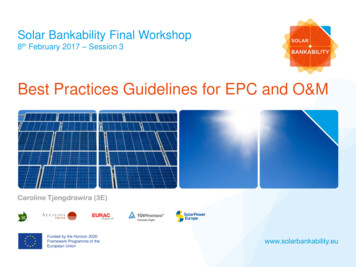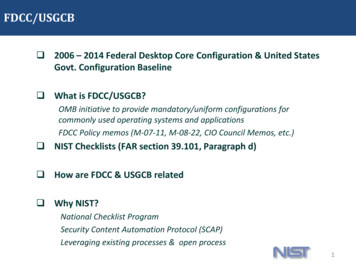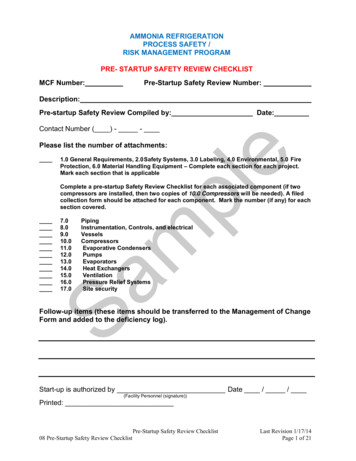
Transcription
Health and Safety Compliance ChecklistThis compliance checklist is intended to be a short overview of the key health and safetyissues that any organisation (including a charity retail organisation) should be consideringfrom a health and safety perspective.It is intended as a basic starting point only and is not an exhaustive list of all health andsafety considerations and is not intended to replace any legal requirement on an organisationto have competent person(s) in place for health and safety.For more detailed information and guidance – please visit the websites indicated belowwhich contain formally issued approved codes of practice and guidance.The Health & Safety Executive also provides a risk assessment tool specifically for charityshops. Please visit: http://www.hse.gov.uk/risk/charity-shop.htmThe Health and Safety at Work Act requires all employers to ensure so far as is reasonablypracticable that they provide: A safe place of workSafe access and egressSafe plant and systems of workSafe use, handling, storage and transport of articles and substancesProvision of information, instruction, supervision and trainingDocumented health and safety policy statement (5 or more employees)It is accepted practice (and expectation) within charity retail that the following topics andrequirements apply to both employees and volunteers.TopicRelevantLegislation Key RequirementsFurtherinformationFireRegulatory ReformFire Safety Order(England andWales)(Fire (Scotland)Act)(Fire Safety(Northern Ireland)Regulations ) ety-lawand-guidancedocuments-forbusinessControl ofAsbestosRegulations Fire policyFire risk assessment –carried out by a competentpersonOperational management ofthe fire triangle – fuel, heatand oxygenFire evacuation proceduresMeans for raising the alarmFire awareness trainingInspection, maintenanceand testing of fire equipment(e.g. fire alarm, emergencylighting and fireextinguishers)Asbestos policyAsbestos survey carried out(initial management surveyand then additional R & DAsbestos http://www.hse.gov.uk/asbestos/
LegionellaCoSHHRegulationsL8 Approved Codeof Practice Slips, trips andfallsWorkplace(Health, Safetyand Welfare)Regulations Competency,training andrecordsManagement ofHealth and Safetyat WorkRegulations Communication andconsultationManagement ofHealth and Safetyat WorkRegulations survey if works are plannedon the property)Asbestos awareness trainingfor any staff or volunteerswho may disturb asbestosContractor managementprocedures requiredensuring they see the surveyand sign to confirm theyhave seen itLegionella and waterhygiene policyLegionella and waterhygiene risk assessment –carried out by a competentpersonLegionella management plan(e.g. water temperaturemonitoring)Documented roles andresponsibilities requiredOperational management offloor surfaces – ensuremaintained in goodconditionManagement of trip hazards– cables, stock and displaysTraining policyAll organisations must havea “competent” person forhealth and safety – this maybe an internal or externalrole or consist of acombination of bothDocumented health andsafety roles andresponsibilitiesCompetency of employeesand volunteers importantTraining needs analysiscarried outTraining records of alltraining carried out requiredRefreshers may be neededHealth and safety policystatementHealth and safetynoticeboardHSE health and safety lawposterMethod for two waycommunication with staffand volunteers on healthand safety issues (e.g. lvement/1996.htm
IncidentreportingManagement ofHealth and Safetyat WorkRegulations Lone working,personal safetyand violenceand aggressionManagement ofHealth and Safetyat WorkRegulations New andexpectantmothersManagement ofHealth and Safetyat WorkRegulations Equipment atWork Regulations EquipmentsafetyProvision and Useof WorkEquipmentRegulations(PUWER)Lifting Operationsand LiftingEquipmentRegulations(LOLER)Management ofHealth and Safetyat WorkRegulations Equality Act Young personsEquality /Disability representatives and orhealth and safetycommittee)Consultation method onchanges to existing systemsand introduction of newonesIncident management policyIncident reporting system tobe in placeIncident report monitoringrequired to determine trendsand themesRIDDOR reportingLone working policyRisk assessmentDocumented systems,procedures and controlsrequiredNew and expectant motherspolicySpecific risk assessmentrequiredReasonable adjustments(may be) requiredRisk assessmentrequirement for PPESupply PPEIf re-usable, inspect andreplace (where appropriate)Inspection, maintenanceand testing regime for workequipment (e.g. portableappliance testing)Inspection, maintenanceand testing regime for liftsand lifting equipmentYoung persons policySpecific risk assessmentrequiredAdditional controls andmonitoring requiredEquality policyAccess audit - carried out bya competent personPersonal EmergencyEvacuation Plan (PEEP) forpeople with disabilities andlearning difficulties -act2010.htm
Chemicals andsubstancesManualhandlingControl ofSubstancesHazardous toHealthRegulationsManual HandlingOperationsRegulations WelfareArrangementsWorkplace(Health, Safetyand Welfare)Regulations First AidFirst Aid at WorkRegulationsDisplay ScreenEquipment(DSE) (whereDSE is in placee.g. computeror laptop)ContractorsHealth and Safety(Display ScreenEquipment)Regulations Management ofHealth and Safetyat WorkRegulations Approved substances listMaterial safety data sheetsobtained for ALL substancesCoSHH assessments carriedout for hazardoussubstancesCoSHH awareness trainingManual handling policyAvoid hazardous manualhandlingCarry out manual handlingrisk assessments forsignificant manual handlingactivitiesReduce the risk of injuryManual handling trainingProvide mechanical aids(where appropriate)Welfare policyPlaces to rest and heat mealsReasonable temperatureVentilationFacilities to make hot drinksSupply of drinking (potable)water – this can be tap waterif confirmed to be “potable”Cleaning arrangementsWaste managementarrangementsSuitable lightingSufficient spaceFirst aid policyRisk assessmentFirst aid suppliesFirst aid arrangementsTrained first aiders (whereappropriate)DSE policyWorkstation assessmentscarried out for DSE usersAppropriate workstation setuphttp://www.hse.gov.uk/coshh/Contractor managementpolicyContractor sign in / outprocess and contractorinductionRisk assessment and methodstatementsPermits to e.gov.uk/msd/dse/
RiskassessmentDrivingWorking atheightManagement ofHealth and Safetyat WorkRegulations Management ofHealth and Safetyat WorkRegulationsWorking at HeightRegulations Risk assessments in placefor key activities and/orrolesSafe systems of work inplace (where appropriate)Driving policyRisk assessmentDriver competency and duediligence checksWorking at height policyAvoid work at heightPrevent fallsMinimise consequencesWorking at height trainingProvide access equipment(where htmWith thanks to Claire Guise,Health & Safety Manager, Marie Curie Cancer CareDisclaimer: This document is not intended to be legally or technically comprehensive and we cannot beheld responsible for any errors or omissions, factual or otherwise, arising from reliance on it. In any event,no action should be taken on matters covered in this document without taking independent professionaladvice.
Fire risk assessment - carried out by a competent person Operational management of the fire triangle - fuel, heat and oxygen Fire evacuation procedures Means for raising the alarm Fire awareness training Inspection, maintenance and testing of fire equipment (e.g. fire alarm, emergency lighting and fire
